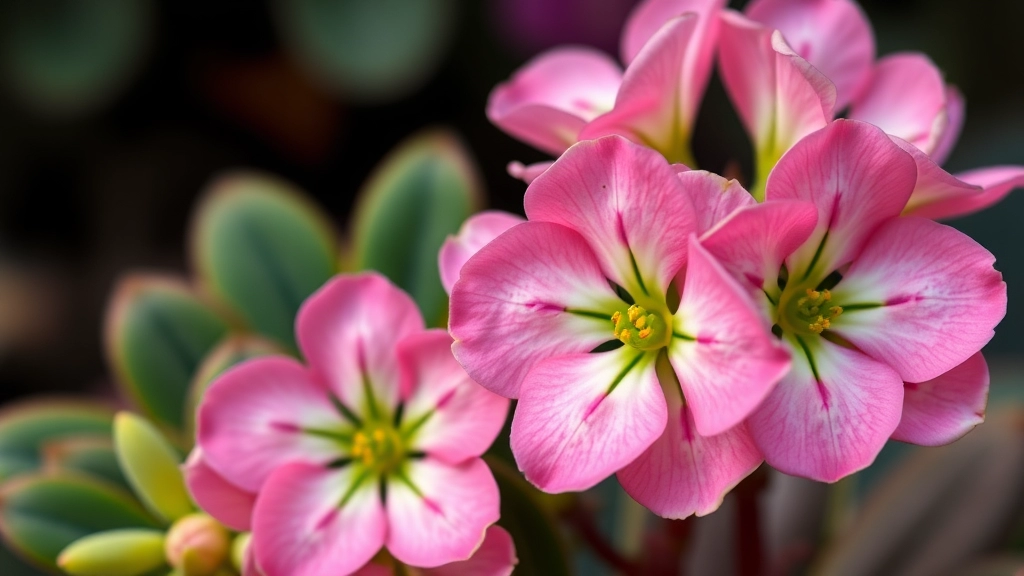Kalanchoe Blossfeldiana Hybrids
As a plant enthusiast and Kalanchoe aficionado, I’m thrilled to take you on a colorful journey through the world of Kalanchoe blossfeldiana hybrids. These vibrant succulents are not just eye-catching; they’re also incredibly versatile and easy to care for. From their stunning variety of colors to their low-maintenance nature, there’s so much to love about these little beauties.
In this article, we’ll explore everything from the diverse range of Kalanchoe blossfeldiana hybrids to their optimal growing conditions. We’ll dive into propagation methods, common pests and diseases, and seasonal care tips. Whether you’re a seasoned plant parent or a curious newcomer, you’ll find valuable insights to help your Kalanchoe thrive. Let’s get started on this exciting botanical adventure!
Varieties and Hybrids of Kalanchoe Blossfeldiana
Ever wondered about the different types of Kalanchoe Blossfeldiana out there?
Let’s dive into this colourful world of succulents.
Kalanchoe Blossfeldiana, also known as flaming katy, comes in a rainbow of varieties.
You’ve got your classic red, but that’s just the tip of the iceberg.
Think pink, orange, yellow, and even white.
Some popular hybrids include:
- ‘Calandiva’: Double flowers that look like mini roses
- ‘Jacqueline’: Bright yellow blooms that’ll light up any room
- ‘Simone’: Deep red flowers that pack a punch
Breeders are always cooking up new hybrids.
They’re playing with flower shapes, colours, and even plant size.
Some newer varieties are more compact, perfect for small spaces.
Others have longer-lasting blooms, giving you more bang for your buck.
Want something unique? Look for variegated varieties.
These have leaves with different colours or patterns.
Remember, each variety might need slightly different care.
But don’t worry, they’re all pretty low-maintenance.
Whether you’re a newbie or a plant pro, there’s a Kalanchoe Blossfeldiana hybrid for you.
So, which one catches your eye?
Optimal Growing Conditions for Kalanchoe Blossfeldiana Hybrids
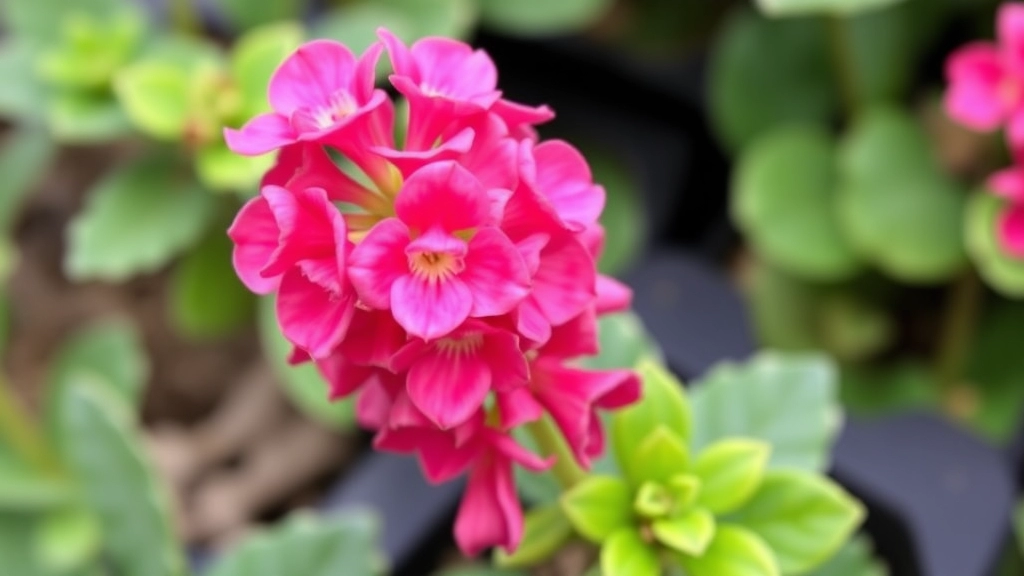
Alright, let’s dive into the optimal growing conditions for Kalanchoe Blossfeldiana hybrids. Trust me, getting these right can make or break your plant game.
Ever wondered why your Kalanchoe looks a bit… meh? It’s probably not living its best life. Let’s fix that.
Light: The Goldilocks Zone
These succulents are picky about light. Too much, they burn. Too little, they stretch out like they’re reaching for the stars.
- Bright, indirect light is the sweet spot
- 4-6 hours of sunlight daily keeps ’em happy
- East or west-facing windows are perfect
Pro tip: If your Kalanchoe’s leaves are pale or stretching, it’s begging for more light. Move it closer to a window, but not in direct sun.
Temperature: Keep It Cozy
Kalanchoes aren’t fans of extreme temps. They’re like us – they want it just right.
- Ideal range: 60-85°F (15-29°C)
- Can tolerate down to 40°F (4°C), but why push it?
- Avoid drafts and sudden temperature changes
Humidity: Not Too Fussy
Good news: These plants aren’t drama queens about humidity. But a little extra can go a long way.
- Average room humidity is fine
- If it’s super dry, mist occasionally or use a pebble tray
- Avoid getting water on the leaves to prevent fungal issues
Soil: Well-Draining is Key
Kalanchoes hate wet feet. Think quick-draining soil that doesn’t hold water like a sponge.
- Mix potting soil with perlite or sand (2:1 ratio)
- Cactus mix works great too
- Make sure the pot has drainage holes
Pot Size: Don’t Go Overboard
These plants like to be a bit root-bound. It’s weird, I know, but trust me on this.
- Choose a pot just slightly larger than the root ball
- Repot every 2-3 years or when roots start peeking out
Remember, Kalanchoe Blossfeldiana hybrids are tough cookies, but they’ll thrive if you nail these conditions. It’s not rocket science, just a bit of plant know-how. Get these basics right, and you’ll have a blooming beauty in no time.
Propagation Methods for Kalanchoe Blossfeldiana Hybrids
Alright, let’s dive into propagating Kalanchoe Blossfeldiana hybrids.
It’s easier than you might think.
Here’s the deal:
Leaf Cuttings: The Lazy Gardener’s Dream
- Take a healthy leaf.
- Let it dry for a day or two.
- Stick it in some well-draining soil.
- Water sparingly.
- Watch it grow.
Stem Cuttings: For the Impatient Ones
- Snip a 3-4 inch stem.
- Remove lower leaves.
- Dip in rooting hormone if you’re fancy.
- Plant in moist soil.
- Keep warm and slightly humid.
Seeds: The Long Game
- Collect seeds from spent flowers.
- Sow on top of soil.
- Keep moist but not waterlogged.
- Be patient. Like, really patient.
Division: The Instant Gratification Method
- Carefully separate root clumps.
- Replant each section.
- Water and watch them thrive.
Pro tip: Spring and summer are your best mates for propagation.
Remember, Kalanchoe Blossfeldiana hybrids love a bit of neglect.
Don’t fuss too much.
Give them light, warmth, and well-draining soil.
Before you know it, you’ll have a Kalanchoe army.
Any of these methods tickle your fancy?
Give ’em a go and let me know how it goes.
Propagating Kalanchoe Blossfeldiana hybrids is a fun way to expand your collection on the cheap.
Common Pests and Diseases Affecting Kalanchoe Blossfeldiana
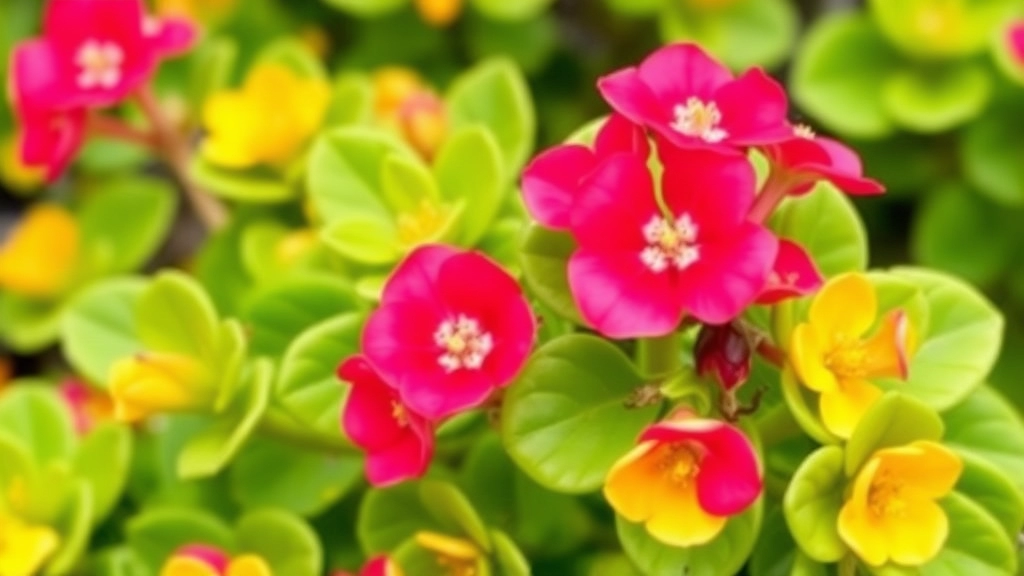
Ever wondered why your Kalanchoe’s looking a bit under the weather? Let’s chat about the usual suspects that might be messing with your plant.
Pesky Critters
First up, we’ve got those tiny troublemakers:
- Mealybugs: These little cotton-like pests love to suck the life out of your Kalanchoe.
- Spider mites: Barely visible, but they can do a number on your plant’s leaves.
- Aphids: Small but mighty, these guys can multiply faster than you can say “Kalanchoe”.
Tip: A quick spray with neem oil or insecticidal soap can often sort these out. No need for fancy chemicals!
Fungal Foes
Now, let’s talk about the sneaky diseases that can creep up on your Kalanchoe:
- Powdery mildew: Looks like someone dusted your plant with flour. Not cool.
- Root rot: This one’s a real pain, often caused by overwatering.
- Botrytis blight: Grey mould that loves humid conditions.
Here’s the thing: prevention is way easier than cure. Keep your Kalanchoe in a spot with good air circulation and don’t overwater. Trust me, it’ll thank you.
Viral Villains
Lastly, we’ve got viral infections. These are trickier to deal with:
- Kalanchoe mosaic virus: Causes weird patterns on leaves.
- Kalanchoe top-spotting virus: Exactly what it sounds like – spots on the top of leaves.
Bad news: there’s no cure for viral infections. If you spot these, it’s best to say goodbye to the affected plant to protect your other green buddies.
Remember, a healthy Kalanchoe is your best defence against pests and diseases. Keep it happy with the right light, water, and TLC, and it’ll be much better equipped to fight off these common problems.
So, next time you’re eyeing your Kalanchoe, keep an eye out for these common pests and diseases. Catching them early can make all the difference in keeping your plant thriving. After all, a little vigilance goes a long way in the plant parent game!
Seasonal Care Tips for Kalanchoe Blossfeldiana Hybrids
Ever wondered how to keep your Kalanchoe looking fab all year round? I’ve got you covered.
Let’s break it down by season:
Spring:
- Time to wake up those sleepy plants
- Gradually increase watering and light exposure
- Perfect time for repotting if needed
Summer:
- These guys love the heat, but not scorching sun
- Water more frequently, but don’t drown ’em
- Watch out for pests – they love the warm weather too
Autumn:
- Start prepping for winter
- Reduce watering and fertilising
- Move indoor plants away from cold windows
Winter:
- Kalanchoe’s beauty sleep time
- Water sparingly – once every 2-3 weeks is plenty
- Keep them cosy, away from drafts and radiators
Pro tip: Kalanchoes are short-day plants. Want blooms in winter? Give them 14 hours of darkness daily for about 6 weeks.
Remember, these are tough little cookies. They can handle a bit of neglect, but show them some love and they’ll reward you with stunning blooms.
Got any Kalanchoe care hacks? I’d love to hear ’em!
Best Practices for Watering Kalanchoe Blossfeldiana
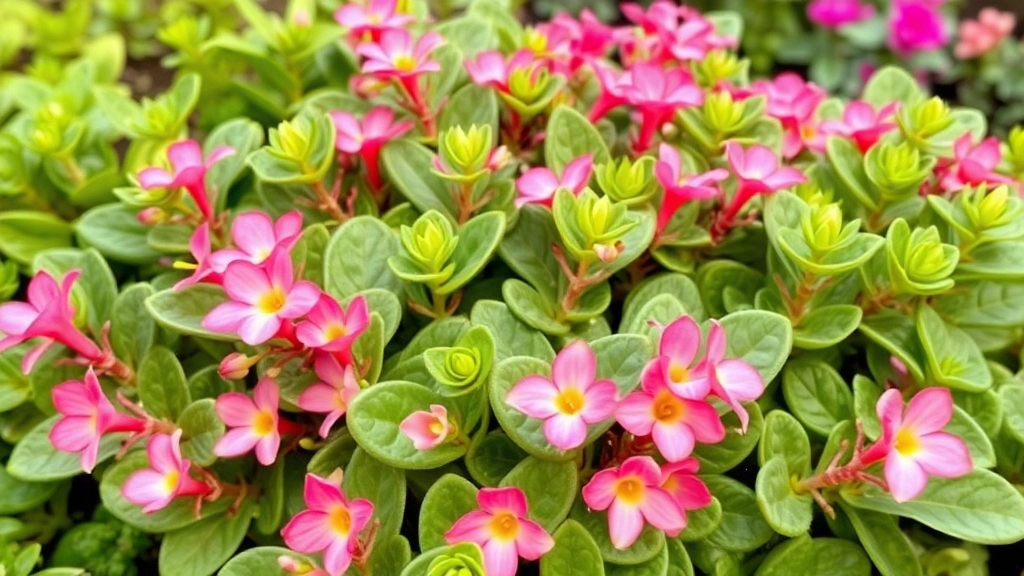
Alright, let’s dive into watering these beauties without drowning them, shall we? Kalanchoe Blossfeldiana is a bit of a drama queen when it comes to water. Too much, and you’ve got a soggy mess. Too little, and it’s giving you the silent treatment.
Here’s the deal:
1. The Finger Test
First things first, stick your finger about an inch into the soil. If it’s dry, it’s showtime. If it’s still damp, hold your horses. This plant likes to dry out between waterings.
2. Watering Frequency
- Summer: Once a week might do the trick
- Winter: Dial it back to every 2-3 weeks
But hey, don’t set this in stone. Your plant’s needs might vary based on its environment.
3. How to Water
When you do water, go all in. Drench that soil until water runs out the bottom. Then let it drain completely. No one likes wet feet, especially not Kalanchoe.
4. Watch for Signs
Droopy leaves? Might be thirsty.
Yellow leaves? Ease up, you’re drowning it.
5. Container Matters
Use a pot with drainage holes. No exceptions. Standing water is a one-way ticket to root rot town.
6. Water Quality
If your tap water’s hard, consider rainwater or filtered water. Your Kalanchoe will thank you by not throwing a fit with brown leaf tips.
7. Time of Day
Morning watering is best. Gives the plant time to dry before nightfall, reducing the risk of fungal issues.
Remember, it’s better to underwater than overwater. These succulents are tough cookies and can bounce back from drought easier than from drowning.
Pro Tip: If you’re going on holiday, don’t ask your overzealous neighbour to water your Kalanchoe daily. It’ll probably be happier without the attention for a week or two.
Bottom line: Watering Kalanchoe Blossfeldiana isn’t rocket science, but it does require a bit of attention. Get it right, and you’ll have a happy, blooming plant that’ll make your green thumb the talk of the town.
Fertilization Guidelines for Healthy Growth
Alright, let’s dive into fertilizing Kalanchoe Blossfeldiana hybrids. Here’s the scoop:
Feeding your Kalanchoe isn’t rocket science, but it’s crucial for those vibrant blooms.
Here’s what you need to know:
1. Timing is everything
- Feed during the growing season (spring and summer)
- Ease off in autumn and winter
2. Less is more
- Over-fertilizing can burn roots and mess with flowering
- Stick to a balanced, water-soluble fertilizer
3. The magic formula
- Look for a 20-20-20 or 10-10-10 mix
- These numbers represent nitrogen, phosphorus, and potassium
4. How often?
- Every 2-4 weeks during active growth
- Once a month in cooler seasons
5. Dilute, dilute, dilute
- Always follow package instructions
- When in doubt, use half the recommended strength
Pro tip: Organic fertilizers work great too. Think compost tea or fish emulsion.
Watch for signs of over-fertilization:
- Leaf burn
- Stunted growth
- Wilting
Remember, Kalanchoes are tough cookies. They don’t need much pampering.
If your plant looks healthy and blooms well, you’re on the right track.
Got questions about fertilizing your Kalanchoe? Hit me up in the comments!
Pruning Techniques for Kalanchoe Blossfeldiana Hybrids
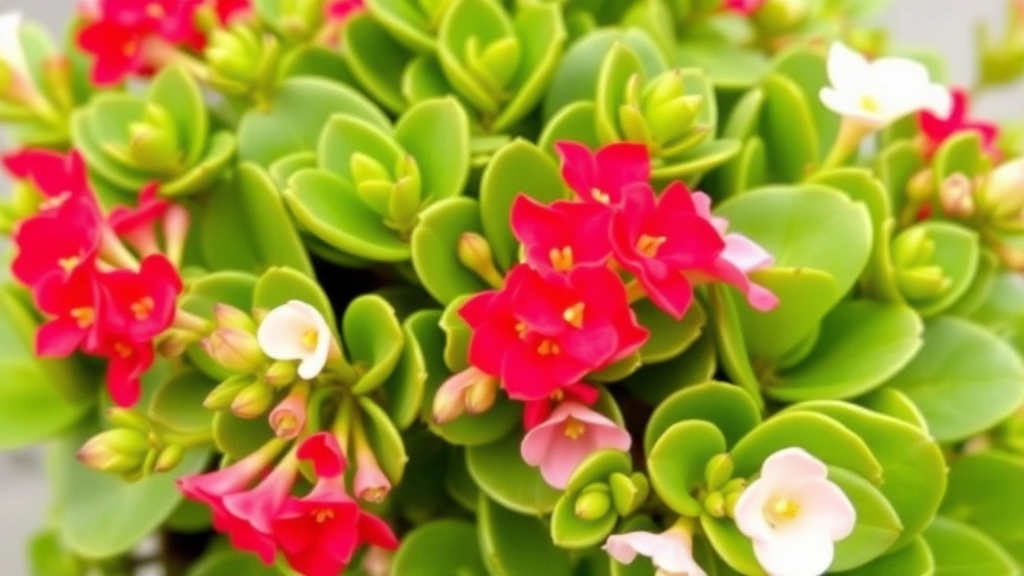
Alright, let’s chat about pruning your Kalanchoe Blossfeldiana hybrids. Trust me, it’s not as scary as it sounds. I’ve been there, staring at my plant, scissors in hand, wondering if I’m about to make a huge mistake. But here’s the deal: pruning is like giving your plant a haircut – it’s all about keeping it healthy and looking its best.
Why bother pruning?
- Encourages bushier growth
- Removes dead or dying bits
- Keeps your plant looking tidy
- Can help with flowering
When to prune?
The best time to prune is right after flowering. Your plant’s put on a show, and now it’s time for a little TLC.
How to prune Kalanchoe Blossfeldiana hybrids:
1. Grab your tools
You’ll need:
- Clean, sharp scissors or pruning shears
- Disinfectant (rubbing alcohol works great)
Pro tip: Always clean your tools before and after pruning. It’s like washing your hands – keeps nasties from spreading.
2. Look for the right spots
- Find stems that are leggy or stretching out
- Spot any dead or yellowing leaves
- Check for flower stalks that have finished blooming
3. Make the cut
- For leggy stems: Cut just above a leaf node (that’s where new growth will sprout)
- Dead leaves: Gently pull them off or snip close to the stem
- Spent flower stalks: Cut these right back to the base
4. Don’t go overboard
Here’s the thing – you’re not giving your Kalanchoe a buzz cut. Take it easy. Remove no more than 1/3 of the plant at a time. It’s not a race, and your plant will thank you for being gentle.
5. Post-pruning care
- Give your plant a good drink
- Place it somewhere with bright, indirect light
- Hold off on fertiliser for a couple of weeks
Common pruning mistakes to avoid:
- ❌ Pruning during active flowering (unless absolutely necessary)
- ❌ Using dirty tools (hello, plant diseases!)
- ❌ Cutting too close to the main stem or too far from a leaf node
- ❌ Removing more than 1/3 of the plant at once
Remember, pruning Kalanchoe Blossfeldiana hybrids isn’t rocket science. It’s about giving your plant a little shape-up to keep it healthy and happy. Start small, be confident, and before you know it, you’ll be pruning like a pro. Your Kalanchoe will be the envy of all your plant-loving mates!
Indoor vs. Outdoor Cultivation of Kalanchoe Blossfeldiana
Let’s chat about growing Kalanchoe Blossfeldiana indoors vs outdoors.
It’s a hot topic among plant lovers, and for good reason.
These colourful succulents can thrive in both settings, but there are some key differences to keep in mind.
Indoor Cultivation:
- Perfect for those with limited outdoor space
- Easier to control temperature and humidity
- Protection from extreme weather conditions
- Ideal for year-round blooming
But here’s the catch – indoor Kalanchoes need more attention to light.
You’ll want to place them near a bright window, but not in direct sunlight.
Outdoor Cultivation:
- More natural light exposure
- Better air circulation
- Potential for larger, more robust plants
- Seasonal blooming cycles
The downside? You’ve got to watch out for frost and heavy rain.
Kalanchoes aren’t fans of cold, wet feet.
So, which is better?
Honestly, it depends on your lifestyle and local climate.
I’ve had success with both, but I lean towards indoor cultivation for more consistent results.
Remember, whether indoors or out, Kalanchoe Blossfeldiana needs well-draining soil and moderate watering.
It’s all about finding that sweet spot between neglect and overcare.
Popular Uses and Display Ideas for Kalanchoe Blossfeldiana Hybrids
Ever wondered how to make your space pop with some seriously cool plants? Let me tell you, Kalanchoe Blossfeldiana hybrids are the way to go. These little beauties are like the Swiss Army knife of the plant world – versatile, eye-catching, and oh-so-easy to work with.
Indoor Decor That Packs a Punch
Listen, I’ve been there. You’re staring at your living room, thinking it needs… something. Here’s where Kalanchoe comes in:
- Coffee table centrepiece: Grab a funky pot, pop in a vibrant Kalanchoe, and boom – instant conversation starter.
- Windowsill wonder: Line up a few different coloured hybrids. It’s like a mini flower show right in your home.
- Bathroom buddy: These guys love humidity. Stick one by the sink and watch it thrive.
Outdoor Stunners
Now, let’s take this show outside:
- Hanging baskets: Kalanchoe cascading over the edges? Chef’s kiss.
- Mixed planters: Pair them with other sun-lovers for a container that screams ‘look at me!’
- Rock garden rock star: Tuck them between stones for a pop of colour that’ll make your neighbours jealous.
Gift-Giving Gold
Need a pressie that’ll make you look like a thoughtful genius?
- Housewarming hero: Nothing says ‘welcome home’ like a cheery Kalanchoe.
- Get well soon: Brighten up a hospital room with these low-maintenance beauties.
- Birthday blooms: Forget boring bouquets. A potted Kalanchoe keeps on giving.
Office Oasis
Cubicle looking a bit… meh? Kalanchoe to the rescue:
- Desk buddy: A small pot next to your computer = instant mood lift.
- Meeting room marvel: Stick one in the corner and watch productivity soar (okay, maybe that’s a stretch, but it’ll look nice).
Party Perfection
Throwing a shindig? Kalanchoe’s got your back:
- Table decorations: Scatter mini pots along the table for an effortless, elegant look.
- Outdoor party pick-me-up: Line your patio with these colourful characters.
The Bottom Line
Look, Kalanchoe Blossfeldiana hybrids are like the chameleons of the plant world. They fit in anywhere, add a splash of colour, and don’t demand much in return. Whether you’re decking out your digs, jazzing up the office, or just want to impress your mates with your green thumb, these little legends have got you covered. So go on, get creative, and let Kalanchoe work its magic in your space.
FAQs about Kalanchoe Blossfeldiana Hybrids
Q: How often should I water my Kalanchoe Blossfeldiana hybrid?
A: Water your Kalanchoe when the top inch of soil feels dry. This usually means once a week in summer and every 2-3 weeks in winter. Remember, it’s better to underwater than overwater these succulents.
Q: Can I grow Kalanchoe Blossfeldiana hybrids outdoors?
A: Yes, you can grow them outdoors in warm climates (USDA zones 10-11). However, they need protection from frost and excessive rain. In colder regions, it’s best to grow them as indoor plants or bring them inside during winter.
Q: How do I get my Kalanchoe to bloom again?
A: To encourage reblooming, provide your Kalanchoe with 14 hours of complete darkness daily for about 6 weeks. This mimics short winter days and triggers flowering. After this period, resume normal light exposure.
Q: Are Kalanchoe Blossfeldiana hybrids toxic to pets?
A: Yes, Kalanchoe Blossfeldiana is toxic to cats, dogs, and other pets if ingested. Keep these plants out of reach of curious pets to avoid potential health issues.
Q: How often should I fertilize my Kalanchoe?
A: Fertilize your Kalanchoe every 2-4 weeks during the growing season (spring and summer) with a balanced, water-soluble fertilizer. Reduce or stop fertilizing in autumn and winter.
Q: Can I propagate Kalanchoe Blossfeldiana hybrids at home?
A: Absolutely! You can easily propagate Kalanchoe through leaf or stem cuttings. Allow the cuttings to callus for a day or two before planting in well-draining soil.
Q: Why are the leaves on my Kalanchoe turning yellow?
A: Yellowing leaves often indicate overwatering. Ensure your pot has good drainage and allow the soil to dry between waterings. It could also be a sign of nutrient deficiency or too much direct sunlight.
Q: How long do Kalanchoe Blossfeldiana hybrids typically bloom?
A: With proper care, Kalanchoe blooms can last for several weeks to a few months. Some newer hybrids have been bred for longer-lasting blooms.
References
-
University of Florida IFAS Extension – Kalanchoe blossfeldiana Kalanchoe blossfeldiana Poelln., Kalanchoe
-
Missouri Botanical Garden – Kalanchoe blossfeldiana Kalanchoe blossfeldiana
-
Royal Horticultural Society – Kalanchoe blossfeldiana Kalanchoe blossfeldiana

